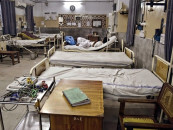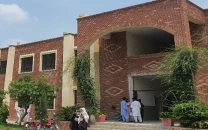Over 50% kilns still on old tech
Brick kiln owners complain of shortage of funds, training

As the country ushered into the New Year, most of the kilns across Punjab (53.78%) still rely on an obsolete technology to make bricks despite continuous government announcements to shift to the latest zig zag technology to avert an environmental crisis in the region.
As per geo-mapping data available with The Express Tribune, the total number of brick kilns in Punjab is 8,554. An official of the Punjab Environment Protection Department (EPD) asserted that 46.21% of the brick kilns (3,953) have installed the new technology and the owners have been given formal licenses to operate the facility. He said at least 747 kilns are currently in the process of deploying the new technology whereas 4,600 kiln owners have completely refused to adopt it. The authorities have now initiated a crackdown against brick kiln owners who have refuse to abide by the government policies. “Although the kiln owners who have given a written assurance to convert to the zig zag technology would be spared during the drive.”
Official sources stated that in Rawalpindi district, at least 10 kilns were sealed under this campaign. Secretary General of Kiln Kasht Association Chaudhry Raheel has urged the government to allow more time for conversion. Brick kiln owners were instructed to revamp their structures by utilizing the zig zag technology before December 31, 2020 to avoid punitive action. The zigzag technology, as the name suggests, dictates zig zag brick placement to allow even heating which enhances product quality. The government had identified brick kilns as a major contributor to air pollution in the province that would choke citizens with the smog phenomenon. To protect the masses, the authorities devised a plan to convert all brick kilns to safer technology. To oversee this technology transfer in the province, the Environment Protection Department (EPD) divided Punjab into four zones: red zone (0-25%) new technology adoption, yellow zone (26-50%), light green zone (51-85%), and dark green zone (86-100%). Prime Minister (PM) Imran Khan’s home district Mianwali has been included in the red zone owing to its poor performance.
Only 10 kilns have so far adopted the mandatory new technology. Along with Mianwali, Layyah, Multan and Faisalabad also demonstrated dismal performance with 7% to 23% zig zag installation ratio. The majority of the districts, 20, were placed in the yellow zone including Rawalpindi, Jhelum, Chakwal, Khanewal and Rahim Yar Khan. Meanwhile, eight districts including Lahore, Kasur, Lodhran and Pakpattan were put in the light green zone. Bahawalnagar district basked in the limelight with its extraordinary 90% conversion ratio followed by Bahawalpur, Vehari and Mandi Bahauddin flaunting 87% kiln conversion. The four districts have therefore been declared the environmentally friendly districts.
While discussing the bottlenecks in the process of technology adoption, Pakistan Kiln Owners Association Secretary General Mehr Abdul Haq said that the government delayed fulfillment of their undertakings. The promised training and loans to the kiln owners for the installation of zig zag technology were not given, he said, highlighting that the government recently formed a committee, which would start providing loans to kiln owners from January 15. Amjad Khan Jagwal, a kiln owner from Multan, believes the new technology is conspiracy against the kiln industry. “It is a Nepali technology and we don’t have the skilled workforce to use it.”



















COMMENTS
Comments are moderated and generally will be posted if they are on-topic and not abusive.
For more information, please see our Comments FAQ